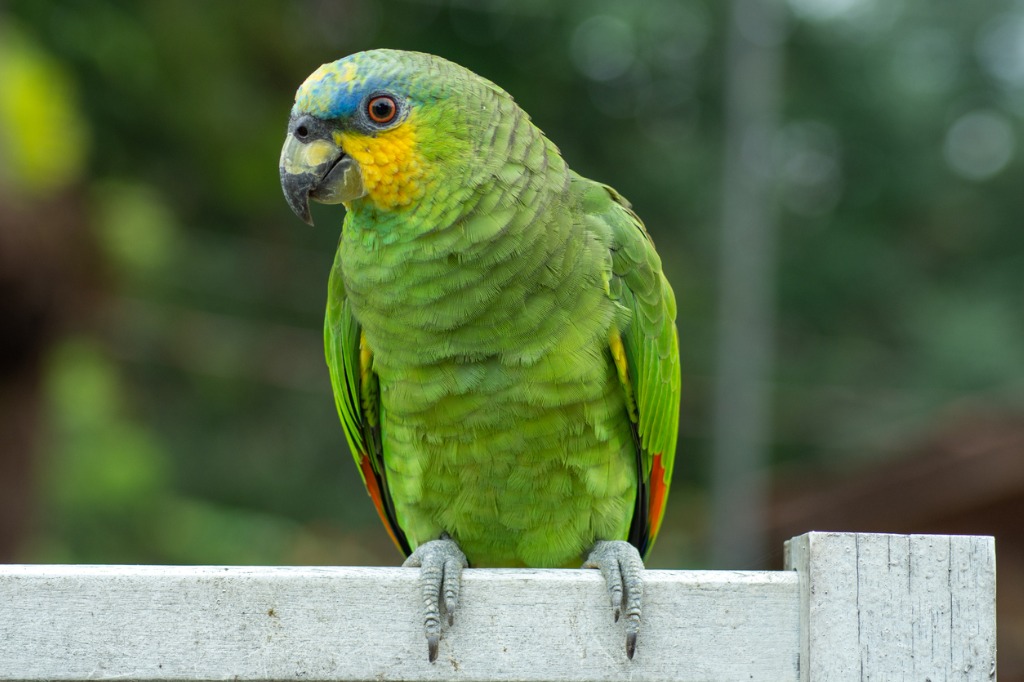Amazon Parrots
 Amazons consist of a wide group of medium sized parrots native to Central and South America. They have short tails and are often mostly green in color. Naturalized flocks of Amazon parrots of various species can be found living in certain parts of southern California. Although no one knows for certain exactly how they got there, they certainly are thriving! Amazons are very vocal and can be quite entertaining. Some have extensive vocabularies and they seem to enjoy singing.
Amazons consist of a wide group of medium sized parrots native to Central and South America. They have short tails and are often mostly green in color. Naturalized flocks of Amazon parrots of various species can be found living in certain parts of southern California. Although no one knows for certain exactly how they got there, they certainly are thriving! Amazons are very vocal and can be quite entertaining. Some have extensive vocabularies and they seem to enjoy singing.
Amazons should be housed in large cages with plenty of time spent out of the cage in a safe environment. As with other species, it is important to keep Amazons occupied with numerous toys and other activities for the day. Teaching a bird to forage for its food items can be very stimulating and help to avoid certain behavioral disorders. More on foraging can be found here. They are many toys available for Amazons at pet stores. Homemade toys can also be used as a lower cost way of adding some stimulating objects for them to play with. Boxes, cardboard paper towel rolls, and cleaned out plastic bottles can be made into various types of toys. Some birds will even enjoy chewing up fresh branches from trees. Woods that are safe for parrots to chew include citrus, apple and fig tree bark.
Perches in the cage should have variable width and texture. Wooden dowel perches should not be used as the only type of perch otherwise issues like bumblefoot (pododermatitis) can occur. Natural wood perches like manzanita, java and dragonwood branches can be used. Cotton and sisal rope can be used as well. Pumice perches can be used to help keep nails trim but must be used cautiously. It is best to have only one pumice perch in the cage and keep it in a location where the bird will not stand on it the majority of the day. Sand paper perches should be avoided.
Getting exposure to ultraviolet- B radiation is recommended for all birds. This type of radiation allows for a bird to naturally make vitamin D3 in its body. This is then utilized to allow for calcium absorption from the diet. Calcium is necessary for normal bone, muscle, reproductive tract and nervous system health. Birds can get exposure to ultraviolet-B radiation by being exposed to unfiltered sunlight. This means getting a bird outside in direct sunlight. Glass windows filter out all this important ultraviolet-B radiation. A bird should be monitored closely while outdoors to ensure it does not over heat or fly away. If you do not have a safe way to give your bird access to unfiltered sunshine, a safe alternative is to provide a lamp that emits ultraviolet-B, such as Zoomed's Avisun 5.0. These lights should be 12-18 inches from the bird and used for around 6 hours a day.
Amazons require a healthy diet just like other birds. It is recommended that the majority of the diet be in the form of a pellet. Fresh vegetables, fruits and grains should make up the remainder. To learn more about general diet recommendations for psittacines click here. If you are switching your Amazon to a pellet diet and need some help please refer to our handout on tips for diet conversion here.

